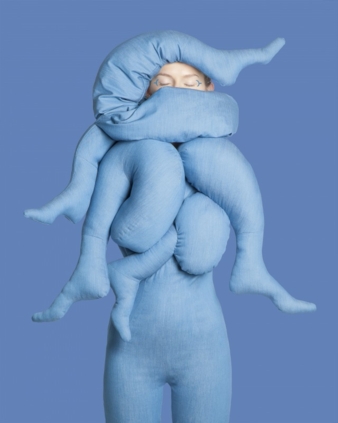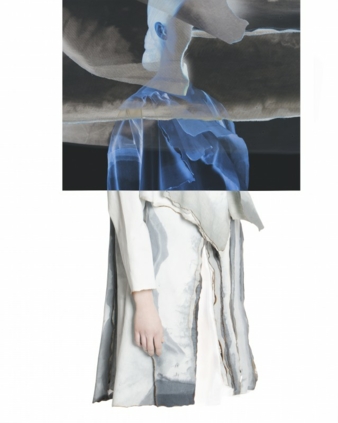27/02/2015 — auf Deutsch lesen
Vicunha: Denim Workshop “Surrealism”
The subject of ‘Surrealism’ was chosen as the point of reference for the denim workshop of Vicunha with Esmod. Given a range of five qualities of denim, the second year students of the Esmod Bachelor Program were asked to execute one silhouette developed by exploratory testing of design possibilities through textile manipulation.
The aim of the Vicunha x Esmod workshop was to allow the students maximum opportunity to experiment, and to enlighten the niche scope of denim with the peculiar word surrealism. “Vicunha has to be on the hot spot of fashion. Either by collaborating closely with the main international jeans labels, or by sponsoring this workshop to support developments of the young fashion designers”, resumes Thomas Dislich, Vicunha managing director for Europe and Asia, the engagement to provide the denim as a basis for the work.
The Denim Workshop The experimental and conceptual nature of surrealism readily lent itself to the workshop, along with the durable nature of denim. The finesse in denim manipulation is controlled deconstruction, and as a starting reference point, the students were introduced to denim treatments already present in the industry such as grinding. This is a popular technique though which graphical outcomes can be achieved, as well as hand sanding, to create a vintage and distressed looks. Students were also introduced to lasering on ready-made jeans, a common practice in which more intricate and elaborate surface compositions can be achieved via a computer generated design. This process is also used as a sustainable approach due to its reduced use of water in the washing and dying stages.
From these starting points students developed their own treatments such as controlled bleaching for colour variation and surface design; unusual applications such as sticking paper to the materials’ surface after which it was pulled away, leaving a marble like finish; hand deconstruction of the fiber structure using scissors to create fraying; as well as cutting up the fabric and recreating the materials through braiding and knotting. Through this innovation students developed silhouettes with the intention of using both form and surface or create their own design code. They were required to execute the unexpected shapes and volume using a high level of finishing.
Using the VICUNHA’s denim materials as the beginning point is an ideal way to lead a research workshop such as this, as it defines the framework for the students. This supports a professional way of designing, as from the very beginning the designer as able to see how the fabric behaves, how it is drapes and moves, and then how this evolves through the textile manipulation. These observations shape the design strategy and create coherence in the overall design. Textile manipulation is closely connected to experimental and avant-garde approaches in the industry, which allows the development of an individual signature, adding layers of richness not present in untreated store bought materials. There is also the economic benefit to students as the development and exploration of treatments enables the student to achieve different textures, which can be simple and low budget, and good starting point for design. Students also benefit in the knowledge sharing of workshops, as they are able to see through common observation the work of their colleagues who in turns aid their own developments.
Once the outfits were completed the students took part in a jury where they presented their concepts and talked through their designs. Present on the jury were fashion photographer Alessandra Bergamin // Alexandra Bondi de Antoni, Editor of i-D Germany // Annette Weygand, Head of Design for Women, Clinton Großhandels GmbH // Creative Director Beck Naylor // Hanna Röhring, Head of Design & Quality Manager at Guido Maria Kretschmer GmbH // independent designer Julius Forgo // Adam Rose, Creative Director at Berlin Alternative Fashion Week. The three selected winners received a flight and ticket to the premium fabric fair Première Vision in Paris, and also had their designs photographed by photographer Alessandra Bergamin. Esmod is pleased to announce the following winners; in first place, Herta Bernane; second went to Sarah Hanisch, and third place to Christina Streitwieser.
About Esmod Berlin International University of Art for Fashion Esmod Berlin has established a reputation as one of the world’s leading fashion schools, drawing on more than 170 years of tradition, a commitment to a to a continually evolving curriculum, and the worldwide network of 23 Esmod fashion schools. As an International University of Art for Fashion, Esmod Berlin is proud of its long tradition with an emphasis on innovative pedagogy and intercultural experience. Since September 2011 Esmod Berlin is officially recognized by the Senate Administration for Education, Science and Research as a University of Art according to § 123 I and II of the Berlin Higher Education Act. Esmod dedicate theirselves to improve fashion education, by inviting professionals around the world into the classroom to nurture and support students’ creativity and emphasize new ways of teaching. Esmod Berlin collaborates also with partners like Goethe Institute, Shenkar University in Tel Aviv, and the Academy of Fine Arts in Warsaw and the IFM in Paris. More information: www.esmod.de/de/berlin/





